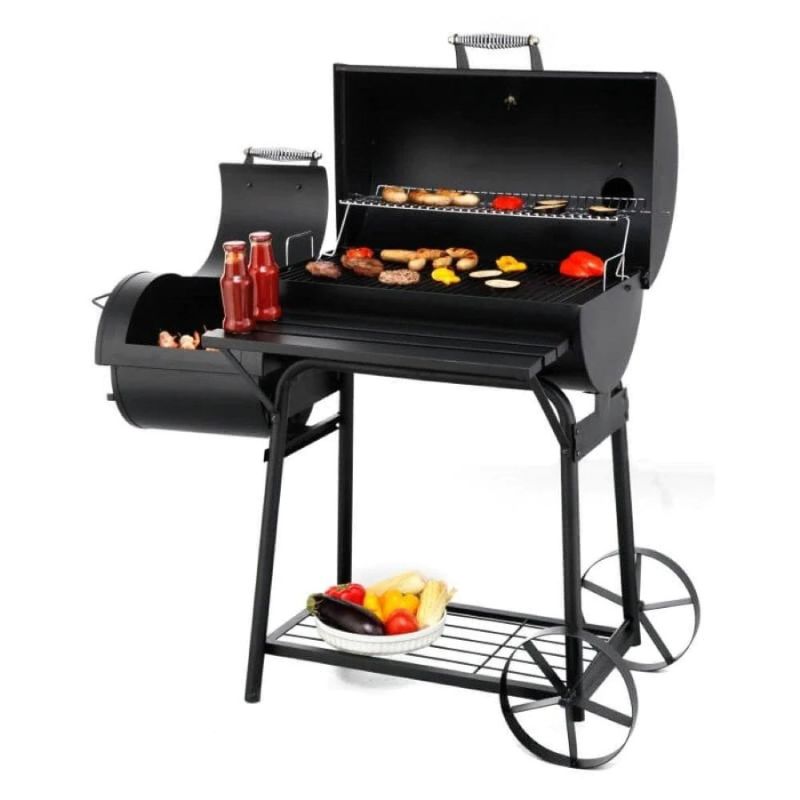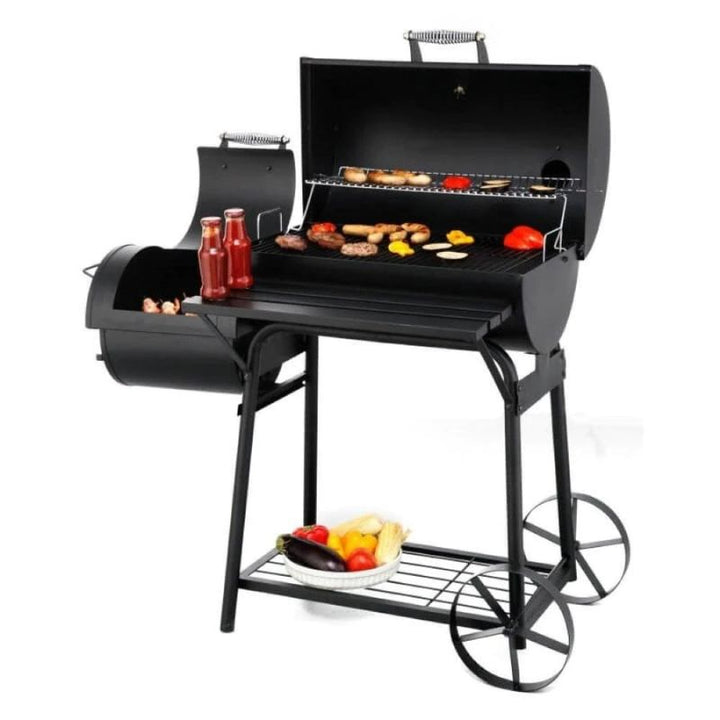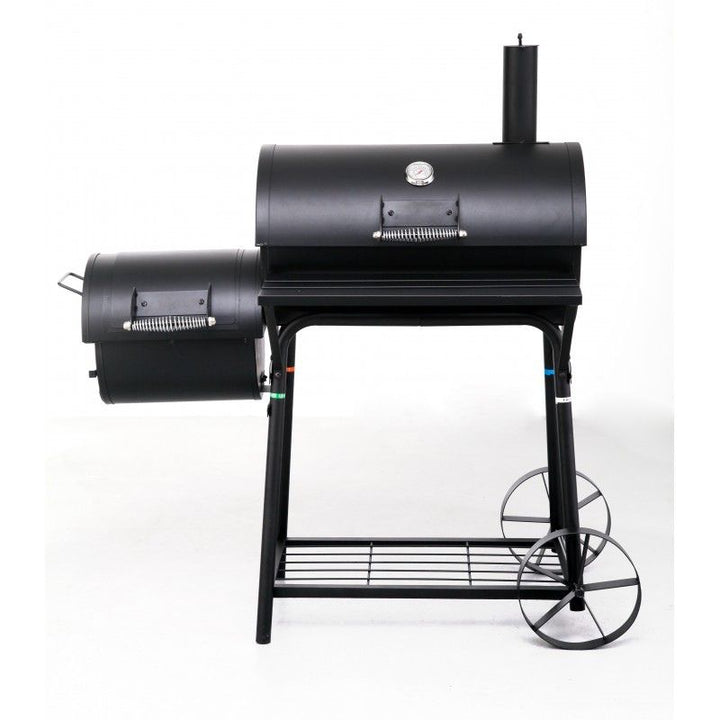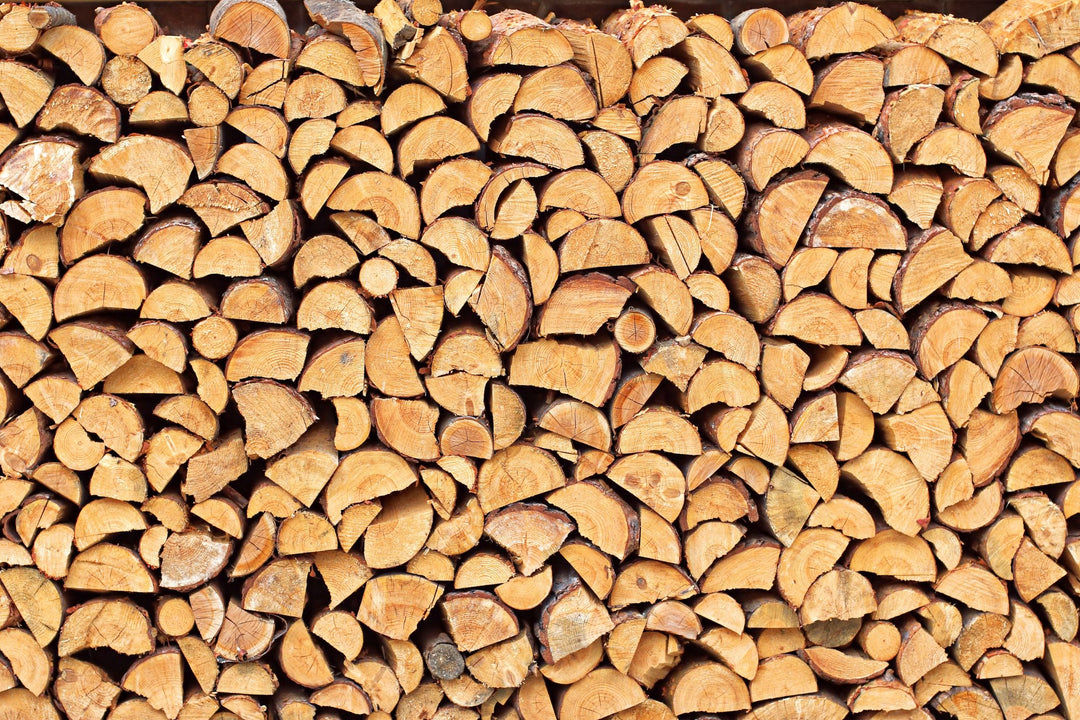Tepro Biloxi BBQ Smoker
- Free shipping to major centers
- Save 15% on accessories with a smoker purchase
The smoker "Biloxi" is a real eye-catcher you can use to cook new and exciting dishes.
This small Western-style smoker combines a variety of different cooking possibilities. Cook your food in the traditional BBQ-style directly over a hot bed of coals on the grill surface. Or cook your food to smoky perfection in the smoke of a wood fire. The grill's special smoker design makes this possible. In the smaller, lower lying smoking chamber, smoke builds from burning wood. This smoke rises and enters the cooking chamber where your food is located.
A chimney feeds the smoke into the cooking chamber. In this way, your food is cooked slowly to smoky perfection at a low temperature of 80° to 130° C. This style of cooking is known as "smoking". Using the lid's built-in thermometer, you can easily monitor the cooking temperature. Smoked food cooks evenly on all sides and retains its juicy consistency. Try different types of wood for new and exciting flavors. You can control the flavor intensity of the smoke using the convenient vents. You don't need to a be a professional to achieve delicious smoked food results! Due to the low cooking temperature, the food cannot burn and hardly needs to be turned.
In addition to smoking, you can also cook food in the main chamber using the direct cooking method. Indirect grilling - where the food lies in a enclosed space, not directly above the flame - This is the barbecue method of choice for gourmets and can be practiced easily with the "Biloxi". Whether you're hosting a traditional BBQ or wish to make exciting smoked dishes this barbecue will give you an all around experience.
Most products will processed, shipped and arrive within 7 to 14 business days. Shipping is usually included in product price. Due to the varied sizes, weights of the products as well as the remoteness of some customer's home address, shipping will be addressed on a purchase by purchase case. You, the customer will be contacted by telephone at the time of the purchase as well when the products arrives to ensure you have a seamless shopping experience. For any individual inquiries please contact us through the contact form for a prompt initial reply.
Welcome to the smoker buying guide!
Whether you're a seasoned pitmaster or just beginning your journey into the world of low and slow cooking, finding the perfect smoker can elevate your outdoor cooking experience to new heights. With a wide variety of styles, sizes, fuel types, and features available, choosing the right smoker can be a daunting task. Fear not! In this guide, we'll walk you through everything you need to know to select the ideal smoker for your needs, preferences, and budget. From understanding different types of smokers to considering key features and accessories, we'll provide you with the knowledge and insight necessary to make a well-informed decision and embark on your flavorful barbecue adventures with confidence.
Propane and Natural Gas Smokers. Propane and natural gas smokers offer a convenient and efficient way to smoke meats and other foods. Here's how they typically work:
Fuel Source. Propane and natural gas smokers are fueled by either propane or natural gas, which is supplied to the barbecue through a dedicated fuel line or propane tank. The gas is ignited using a built-in ignition system, such as a push-button starter or electronic ignition.
Heat Generation. Once ignited, the gas burner heats up the interior of the smoker barbecue, creating a controlled and consistent heat source for cooking. The temperature can be adjusted using the barbecue's built-in temperature controls, allowing for precise heat management during the smoking process.
Smoke Production. To impart flavor to the food being smoked, wood chips or chunks are added to a smoker box or tray located inside the barbecue. As the gas burner heats up the wood chips, they smolder and release aromatic smoke, which infuses the food with a rich, smoky flavor.
Cooking Process. The food to be smoked is placed on cooking racks or shelves inside the smoker barbecue, allowing the smoke and heat to circulate around it evenly. The smoker's insulated design helps maintain a consistent temperature throughout the cooking chamber, ensuring thorough and even cooking.
Smoke and Heat Regulation. Propane and natural gas smokers are equipped with vents, dampers, or adjustable air intake controls that allow users to regulate the flow of smoke and heat inside the cooking chamber. By adjusting these controls, users can fine-tune the smoking process to achieve the desired flavor and texture.
Safety Features. Many propane and natural gas smokers are equipped with safety features such as automatic shut-off valves, flame sensors, and temperature gauges to ensure safe and reliable operation. These features help prevent accidents and ensure a hassle-free smoking experience.
Overall, propane and natural gas smokers offer a convenient and user-friendly way to smoke meats and other foods, allowing for precise temperature control, consistent heat distribution, and flavorful results.
Propane and natural gas smokers offer convenience and versatility for outdoor cooking enthusiasts, but they also have their drawbacks. Here are the pros and cons of propane/natural gas smokers:
Pros
Convenience. Propane and natural gas smokers are incredibly convenient to use. They ignite quickly with the push of a button or the turn of a knob, allowing you to start cooking without the need for charcoal or wood preparation. This convenience makes them ideal for quick and easy outdoor cooking sessions.
Consistent Temperature Control. Propane and natural gas smokers offer precise temperature control, allowing you to maintain a consistent cooking temperature throughout the smoking process. This ensures even cooking and helps prevent fluctuations in temperature that can affect the quality of your smoked meats and other dishes.
Clean Burning. Propane and natural gas are clean-burning fuels that produce minimal smoke, soot, and ash compared to charcoal or wood-fired smokers. This results in a cleaner and more environmentally friendly cooking experience, with fewer emissions and less pollution.
Versatility. Propane and natural gas smokers are versatile and can be used for smoking, grilling, roasting, and other cooking methods. Many models feature adjustable racks, temperature controls, and other features that allow you to customize your cooking experience and experiment with different recipes and techniques.
Long Cooking Times. Propane and natural gas smokers typically have large fuel tanks or a direct connection to your home's natural gas supply, allowing them to run for extended periods without needing to be refilled or replenished. This makes them suitable for smoking large cuts of meat or cooking for extended periods without interruption.
Cons
Dependency on Fuel. Propane and natural gas smokers rely on a steady supply of fuel to operate effectively. If you run out of propane or experience a natural gas outage, you won't be able to use your smoker barbecue until the fuel supply is restored or replenished.
Limited Portability. Propane and natural gas smokers are typically larger and heavier than portable charcoal or electric smokers, making them less portable and more challenging to transport. They are best suited for permanent installation in your outdoor cooking area or patio.
Initial Cost. Propane and natural gas smokers can be more expensive to purchase upfront compared to charcoal or electric smokers. Additionally, if you choose a natural gas model, you may incur installation costs to connect the barbecue to your home's natural gas supply line.
Flavor Differences. Some barbecue purists argue that propane and natural gas smokers produce a different flavor compared to charcoal or wood-fired smokers. While they still impart a smoky flavor to food, it may not be as pronounced or complex as the flavor produced by traditional smoking methods.
Safety Concerns. Propane and natural gas smokers pose certain safety risks, such as the potential for gas leaks, fires, or explosions. It's essential to follow proper safety precautions, including regular maintenance, leak checks, and proper ventilation, to ensure safe operation.
In summary, propane and natural gas smokers offer convenience, consistent temperature control, and versatility for outdoor cooking.
Charcoal Smokers. Charcoal smokers rely on the combustion of charcoal to generate heat and smoke for cooking. Here's a breakdown of how they operate:
Charcoal Production. Wood is superheated to temperatures above 1,000°F, causing most of the non-carbon organic compounds to burn off. The resulting char, which is mostly carbon, is then formed into small briquettes known as charcoal.
Heat Source. Charcoal provides the primary heat source for a charcoal smoker. When lit, it burns cleanly and produces minimal smoke. The combustion of charcoal releases chemicals such as carbon monoxide, carbon dioxide, and nitrogen oxide, which add flavor to the food.
Smoke Production. Additional smoke flavor is imparted to the food using wood chips. These chips are typically placed above the charcoal to smolder and release aromatic smoke during the cooking process.
Temperature Regulation. The amount of heat generated by the charcoal is regulated by air intakes near the coals. By adjusting the airflow, users can control the temperature inside the smoker. More air increases the heat output, while less air results in lower temperatures.
Cooking Process. Most charcoal smokers suspend the food above the coals, allowing the heat and smoke to circulate around it. A chimney and air dampers at the top of the smoker help draw the heat and smoke across the food, ensuring even cooking and flavor distribution.
Air and Smoke Control. Proper airflow and smoke management are essential for successful smoking with charcoal. Too much air can dry out the food and make it tough, while too little air can result in bitter-tasting food due to excessive smoke and ash buildup.
Charcoal smokers offer a traditional and authentic barbecue experience, but they also come with their own set of advantages and disadvantages. Here are the pros and cons:
Pros
Authentic Flavor. Charcoal smokers impart a rich, smoky flavor to food that is highly prized by barbecue enthusiasts. The natural charcoal smoke enhances the taste and aroma of grilled meats, vegetables, and other dishes, creating a mouthwatering culinary experience.
Versatility. Charcoal smokers are versatile and can be used for various cooking methods, including smoking, grilling, roasting, and even baking. They allow for precise temperature
control, allowing you to achieve the desired results for different types of food and cooking styles.
High Heat. Charcoal produces intense heat, making charcoal smokers ideal for high-temperature cooking, such as searing steaks or charring vegetables. The ability to reach high temperatures quickly gives you greater control over the cooking process and allows for a wide range of cooking techniques.
Portability. Charcoal smokers are generally more portable than larger gas or pellet smokers, making them suitable for outdoor gatherings, camping trips, tailgating, and other on-the-go cooking adventures. They don't require access to electricity or gas lines, giving you the flexibility to grill anywhere.
Cost-Effective. Charcoal is often more affordable than propane or natural gas, making charcoal smoker a cost-effective option for outdoor cooking. Additionally, charcoal grills tend to be less expensive to purchase upfront compared to gas or pellet smokers.
Cons
Longer Setup Time. Charcoal smokers require more time and effort to set up and get started compared to gas or pellet smokers. You'll need to light the charcoal and wait for it to reach the desired temperature before you can begin cooking, which can take up to 30 minutes or more.
Cleanup. Charcoal smokers produce ash and debris that require cleanup after each use. Removing ashes from the grill and disposing of them properly can be messy and time-consuming, adding to the post-cooking cleanup process.
Temperature Control. While charcoal smokers offer precise temperature control with practice, they can be more challenging to use for novice grillers compared to gas or pellet smokers. Achieving and maintaining the desired cooking temperature requires skill and experience.
Fluctuating Temperatures. Charcoal smokers may experience fluctuations in temperature during the cooking process, especially if the airflow or charcoal distribution is not properly managed. This can affect the consistency and quality of the final cooked food.
Safety Concerns. Charcoal smokers pose certain safety risks, including the potential for burns, flare-ups, and accidental fires. It's essential to use caution when operating a charcoal grill and to follow proper safety precautions to prevent accidents and injuries.
In summary, charcoal smokers offer authentic flavor, versatility, portability, and cost-effectiveness for outdoor cooking.
Offset Smokers. Offset smokers, also known as offset barrel smokers or horizontal smokers, are popular among barbecue enthusiasts for their ability to impart a rich, smoky flavor to meats and other foods. Here's how they typically work:
Design. Offset smoker consist of two main chambers: a larger cooking chamber and a smaller firebox chamber. The cooking chamber is typically a large barrel-shaped chamber with cooking grates for placing food, while the firebox chamber is located adjacent to the cooking chamber and houses the heat source.
Heat Source. The heat source in an offset smoker is typically charcoal or wood, although some models may also use propane or natural gas. The fuel is burned in the firebox chamber, and the resulting heat and smoke are drawn into the cooking chamber to smoke and cook the food.
Smoke Production. Wood chips, chunks, or logs are added to the firebox chamber to produce smoke, which flavors the food as it circulates through the cooking chamber. The type of wood used can significantly impact the flavor of the smoked food, with popular options including hickory, mesquite, oak, and fruitwoods like apple or cherry.
Cooking Process. The food to be smoked is placed on cooking grates inside the cooking chamber, away from direct heat but close enough to the smoke source to absorb the flavor. The offset design of the smoker allows for indirect cooking, with the heat and smoke circulating around the food for even cooking and flavor distribution.
Temperature Regulation. Temperature control in an offset smoker is typically achieved by adjusting the airflow through vents or dampers located on the firebox and cooking chamber. Opening or closing these vents allows users to regulate the flow of oxygen and heat, thereby controlling the temperature inside the smoker.
Maintenance. Proper maintenance of an offset smoker is essential for optimal performance. This includes regularly cleaning the cooking grates, removing ash and debris from the firebox and cooking chamber, and ensuring that the smoker is properly seasoned to prevent rust and corrosion.
Overall, offset smokers offer a traditional and authentic smoking experience, with the ability to produce tender, flavorful smoked meats and other foods. Their offset design allows for indirect cooking, precise temperature control, and the flexibility to use a variety of wood fuels for different flavor profiles.
Offset smokers - Here are the pros and cons of offsets:
Pros
Authentic Flavor. Offset smokers impart a rich, smoky flavor to meats and other foods, prized by barbecue enthusiasts. The indirect heat and smoke circulation create tender, flavorful results that are difficult to replicate with other cooking methods.
Versatility. Offset smokers are versatile and can be used for smoking, grilling, and even slow-roasting. The large cooking chamber provides ample space for cooking large cuts of meat,
ribs, briskets, and more, making them suitable for feeding a crowd or hosting gatherings.
Precise Temperature Control. Offset smokers offer precise temperature control, allowing users to adjust the airflow to regulate the heat inside the cooking chamber. This enables precise cooking and smoking, ensuring that food is cooked evenly and to perfection.
Large Cooking Capacity. The spacious cooking chamber of an offset smoker allows for cooking large quantities of food at once, making them ideal for backyard barbecues, parties, and events. With multiple cooking racks, you can smoke different types of meat simultaneously to cater to various tastes.
Traditional Design. Many barbecue enthusiasts appreciate the traditional design and aesthetics of offset smokers. Their classic barrel shape, side firebox, and smokestack evoke a sense of nostalgia and authenticity, enhancing the outdoor cooking experience.
Cons
Learning Curve. Using an offset smoker effectively requires some skill and practice. Achieving the perfect balance of heat and smoke, as well as mastering temperature control, airflow adjustments, and smoke management, may take time for beginners to learn.
Space Requirements. Offset smokers can be large and bulky, requiring ample outdoor space for storage and operation. Their size may be a limiting factor for those with limited outdoor space or patio areas.
Maintenance. Offset smokers require regular maintenance to ensure optimal performance and longevity. This includes cleaning the cooking grates, removing ash and debris from the firebox and cooking chamber, and seasoning the smoker to prevent rust and corrosion.
Fuel Management. Managing the fuel source, such as charcoal or wood, can be challenging in an offset smoker. Maintaining a consistent temperature and smoke level requires careful monitoring and replenishing of fuel and wood chips throughout the cooking process.
Temperature Variations. Despite their precise temperature control, offset smokers may experience temperature variations across the cooking chamber. Hot spots and cooler areas can affect the cooking process, requiring occasional rotation or rearrangement of food for even cooking.
In summary, offset smokers offer authentic flavor, versatility, precise temperature control, and large cooking capacity.
Pellet Smokers. Pellet smokers, also known as pellet grills or pellet smokers, are innovative cooking devices that use wood pellets as their primary fuel source. Here's how they typically work:
Pellet Hopper. Pellet smokers feature a hopper located at one end of the grill. This hopper is filled with small hardwood pellets made from compressed sawdust, typically sourced from hardwoods like oak, hickory, cherry, or apple. The pellets are fed into the smoker’s firebox as needed to maintain the desired temperature.
Auger System. Inside the pellet smoker, there's an auger mechanism that delivers the wood pellets from the hopper to the firebox. The speed of the auger is controlled by an electronic controller, which regulates the rate at which pellets are fed into the firebox based on the desired temperature set by the user.
Firebox and Ignition. The firebox in a pellet smoker is typically located beneath the cooking grates and is where the wood pellets are ignited. A heating element, often powered by electricity, ignites the pellets as they enter the firebox, creating a controlled and consistent heat source for cooking.
Temperature Control. Pellet smokers feature advanced temperature control systems that allow users to set and maintain precise cooking temperatures. The electronic controller monitors the temperature inside the grill and adjusts the rate at which pellets are fed into the firebox to maintain the desired temperature.
Convection Cooking. Pellet smokers use a convection cooking method, where hot air circulates evenly around the food, cooking it from all sides. This helps ensure even cooking and eliminates hot spots, resulting in perfectly cooked meats, vegetables, and other foods.
Smoke Production. The wood pellets used in pellet smokers produce a natural, wood-fired flavor that enhances the taste of the food being cooked. Some pellet smokers also feature
additional smoke production mechanisms, such as a smoke tube or diffuser, to further enhance the smoky flavor.
Versatility. Pellet smokers are versatile and can be used for smoking, grilling, roasting, baking, and even searing. Many models offer adjustable temperature settings, allowing users to switch between different cooking methods with ease.
Overall, pellet smoker barbecues offer convenience, precision, and versatility, allowing users to achieve excellent results with minimal effort. Their advanced temperature control systems and natural wood-fired flavor make them a popular choice among barbecue enthusiasts of all skill levels.
Pellet Smokers. Here are the pros and cons of a pellet smoker:
Pros
Convenience. Pellet smokers are incredibly convenient to use. They feature automatic ignition and precise temperature control, allowing users to set their desired cooking temperature and let the grill do the rest. This convenience makes pellet smokers ideal for busy individuals or those new to smoking.
Versatility. Pellet smokers are versatile and can be used for smoking, grilling, roasting, baking, and even searing. Many models offer adjustable temperature settings, allowing users to switch between different cooking methods with ease.
Consistent Temperature. Pellet smokers maintain a consistent cooking temperature throughout the cooking process, thanks to their advanced temperature control systems. This ensures even cooking and eliminates hot spots, resulting in perfectly cooked meats, vegetables, and other foods.
Natural Wood Flavors. Pellet smokers use hardwood pellets as their primary fuel source, which imparts a natural, wood-fired flavor to the food being cooked. The choice of wood pellets, such as oak, hickory, cherry, or apple, allows users to customize the flavor profile of their dishes.
Ease of Use. Pellet smokers are user-friendly and require minimal supervision during the cooking process. Once the desired temperature is set, users can relax and let the grill do the work, freeing up time to socialize with guests or attend to other tasks.
Cons
Dependency on Electricity. Pellet smokers rely on electricity to power their ignition systems, augers, and temperature controllers. If the grill loses power, either due to a power outage or mechanical failure, cooking may be interrupted, and the grill may need to be restarted manually.
Cost of Pellets. Wood pellets used as fuel for pellet smokers can be more expensive than other fuel sources, such as charcoal or propane. Depending on the frequency of use and availability of pellets, the cost of fueling a pellet smoker may add up over time.
Limited Portability. Pellet smokers are generally larger and heavier than portable charcoal or gas grills, making them less portable and more challenging to transport. They are best suited for permanent installation in an outdoor cooking area or patio.
Maintenance. Pellet smokers require regular maintenance to ensure optimal performance and longevity. This includes cleaning the cooking grates, removing ash and debris from the firebox and auger system, and inspecting and replacing worn or damaged parts as needed.
Pellet Availability. The availability of wood pellets may vary depending on location and season. While pellets are widely available at most hardware stores and online retailers, users may need to plan ahead and stock up on pellets to ensure a steady supply for extended cooking sessions.
In summary, pellet smoker barbecues offer convenience, versatility, consistent temperature control, natural wood flavor, and ease of use.
Electric Smokers. Electric smokers are a convenient and user-friendly option for smoking meats, fish, vegetables, and other foods. Here's how they typically work:
Electric Heating Element. The heart of an electric smoker is its heating element, which is powered by electricity. This element is responsible for generating the heat needed to cook and smoke the food.
Temperature Control. Electric smokers feature built-in temperature controls that allow users to set their desired cooking temperature. These controls typically range from low to high temperatures, allowing for precise temperature adjustments to achieve the desired level of smoking and cooking.
Wood Chip Tray. To impart a smoky flavor to the food being cooked, electric smokers use wood chips or chunks. These are placed in a tray or compartment located near the heating element, where they are heated to produce smoke.
Smoke Circulation. The smoke generated from the wood chips circulates inside the cooking chamber, surrounding the food with flavorful smoke. Some electric smokers feature built-in fans or air vents to help circulate the smoke evenly throughout the chamber, ensuring consistent flavor distribution.
Cooking Process. The food to be smoked is placed on cooking racks or shelves inside the smoker's cooking chamber. The electric heating element generates the heat needed to cook the food, while the smoke adds flavor and aroma.
Insulation. Many electric smokers are insulated to help maintain a consistent cooking temperature and retain heat efficiently. This insulation helps ensure even cooking and prevents temperature fluctuations, resulting in perfectly smoked and cooked food.
Convenience. Electric smokers are incredibly convenient to use, making them ideal for beginners or those who prefer a hassle-free smoking experience. Once the desired temperature is set, users can simply add the wood chips, place the food inside the smoker,
and let it cook without the need for constant monitoring or adjustment.
Overall, electric smoker barbecues offer a straightforward and user-friendly way to smoke meats and other foods, with precise temperature control, consistent heat distribution, and minimal effort required. Their convenience and ease of use make them a popular choice among barbecue enthusiasts of all skill levels.
Electric Smokers. Here are the pros and cons of an electric smoker:
Pros
Ease of Use. Electric smokers are incredibly user-friendly, making them ideal for beginners or those who prefer a hassle-free smoking experience. With simple temperature controls and automatic operation, users can set the desired temperature and let the smoker do the work.
Consistent Temperature Control. Electric smokers offer precise temperature control, allowing users to set and maintain the desired cooking temperature throughout the smoking process. This helps ensure even cooking and consistent results, without the need for constant monitoring or adjustment.
Convenience. Electric smokers are convenient to use, requiring minimal effort and supervision during the smoking process. Once the smoker is set up and the desired temperature is selected, users can relax and let the smoker do its job, freeing up time for other tasks or activities.
Indoor Use. Some electric smoker models are suitable for indoor use, making them a practical option for those who want to smoke food year-round, regardless of the weather conditions outside. Indoor electric smokers are often designed with features like insulated construction and smoke containment systems to minimize smoke and odors. These generally can be used on apartment balconies as well.
Safety. Electric smokers are generally safer to use than traditional charcoal or wood smokers, as they don't produce open flames or require combustible fuels. This makes them suitable for use in areas where open flames are prohibited or where fire safety is a concern.
Cons
Limited Flavor. While electric smokers can produce flavorful smoked dishes, some barbecue enthusiasts argue that they may lack the depth of flavor achieved with traditional wood or charcoal smokers. Electric smokers rely on wood chips for smoke flavoring, which may not impart the same intensity or complexity as wood or charcoal. The humid environment is perfect for delicately smoking foods like fish, cheese, vegetables, and sausages. However, achieving a crispy crust on chicken skin or ribs can be more challenging due to this moisture-rich atmosphere.
Dependence on Electricity. Electric smokers require access to electricity to operate, which may be a limitation for outdoor cooking in remote locations or areas without electrical outlets. Additionally, power outages or electrical failures could interrupt the smoking process, potentially affecting the quality of the food being cooked.
Less Authentic Experience. Some barbecue purists prefer the hands-on experience and traditional methods of cooking with charcoal or wood smokers. Electric smokers, with their automated operation and precise temperature control, may lack the authenticity and charm of traditional smoking techniques.
Limited Portability. Electric smokers are typically larger and heavier than portable charcoal or gas grills, making them less portable and more challenging to transport. They are best suited for permanent installation in an outdoor cooking area or patio.
Maintenance. While electric smokers are generally low maintenance, they still require regular cleaning and maintenance to ensure optimal performance and longevity. This includes cleaning the cooking grates, removing ash and debris, and inspecting and replacing worn or damaged parts as needed.
In summary, electric smoker barbecues offer ease of use, precise temperature control, convenience, indoor use capability, and safety advantages.
Kamados. Kamado grills, also known as ceramic grills or kamado cookers, are versatile cooking devices that originate from ancient Japanese cooking methods. Here's how they typically work:
Ceramic Construction. Kamado grills are ypically made from high-quality ceramic materials, which provide excellent insulation and heat retention properties. The thick ceramic walls trap heat inside the grill, allowing for efficient and even cooking.
Airflow Control. Kamado grills feature vents or dampers at the top and bottom of the grill, which allow users to control the airflow and temperature inside the grill. By adjusting the vents, users can regulate the amount of oxygen that reaches the charcoal, thereby controlling the intensity of the fire and the cooking temperature.
Charcoal Fuel. Kamado grills use lump charcoal as their primary fuel source. Lump charcoal is made from natural hardwood and burns hotter and cleaner than briquettes, making it ideal for grilling and smoking. The charcoal is lit using either a chimney starter or an electric starter, and once lit, it is spread evenly across the bottom of the grill.
Heat Retention. The thick ceramic walls of the kamado grill help retain heat, allowing for efficient cooking at high temperatures. This heat retention also makes kamado grills well-suited for low and slow cooking, as they can maintain a consistent temperature over long periods without the need for frequent refueling.
Versatility. Kamado grills are incredibly versatile and can be used for grilling, smoking, roasting, baking, and even pizza-making. The ability to adjust the airflow and temperature allows users to easily switch between different cooking methods and achieve a wide range of culinary results.
Tight Seal. Kamado grills feature a tight-fitting lid that creates a seal when closed, further enhancing heat retention, and allowing for precise temperature control. The seal also helps lock in moisture and flavor, resulting in juicy and flavorful cooked foods.
Ceramic Cooking Surface. Some kamado grills come with ceramic cooking surfaces, such as heat deflectors or pizza stones, which help distribute heat evenly and prevent flare-ups. These surfaces are ideal for cooking delicate foods or achieving a crispy crust on pizzas and baked goods.
Overall, kamado grills offer efficient heat retention, precise temperature control, versatility, and excellent cooking results, making them a popular choice among barbecue enthusiasts and outdoor cooks. Their unique design and functionality allow for a wide range of cooking techniques and culinary creations.
Kamado Grill. Here are the pros and cons of a Kamado grill:
Pros
Versatility. Kamado grills are incredibly versatile cooking devices that can grill, smoke, roast, bake, and even sear. Their ability to maintain precise temperature control allows for a wide range of cooking techniques and culinary creations.
Excellent Heat Retention. The thick ceramic walls of Kamado grills provide exceptional heat retention, allowing for efficient cooking at high temperatures and long, slow cooks at low temperatures. This makes them ideal for both quick grilling sessions and low and slow barbecue.
Precise Temperature Control. Kamado grills feature adjustable vents or dampers at the top and bottom, allowing users to control the airflow and temperature inside the grill with precision. This enables users to achieve and maintain the desired cooking temperature for extended periods without the need for constant adjustments.
Fuel Efficiency. Kamado grills are fuel-efficient, requiring less charcoal compared to traditional charcoal grills or smokers. The tight seal of the grill's lid and the efficient heat retention properties of the ceramic construction help maximize fuel efficiency, resulting in longer cook times per fuel load.
Even Cooking. The ceramic construction and tight-fitting lid of Kamado grills help distribute heat evenly throughout the cooking chamber, ensuring consistent cooking results across the entire grill surface. This helps prevent hot spots and ensures that food is cooked evenly and thoroughly.
Durability. Kamado grills are built to last, with high-quality ceramic construction that is resistant to rust, corrosion, and damage from high temperatures. With proper care and maintenance, a Kamado grill can provide years of reliable performance and enjoyment.
Cons
Weight and Portability. Kamado grills are typically heavy and bulky, making them less portable than other types of grills. Their ceramic construction adds to their weight, making them challenging to transport or move around, especially for outdoor events or camping trips.
Learning Curve. Using a Kamado grill effectively requires some skill and practice, particularly when it comes to mastering temperature control and airflow adjustment. Beginners may need some time to familiarize themselves with the grill's operation and cooking techniques.
Initial Cost. Kamado grills tend to be more expensive upfront compared to other types of grills, such as gas or charcoal grills. The high-quality ceramic construction and versatile
functionality of Kamado grills justify their higher price tag, but they may not be within everyone's budget.
Maintenance. While Kamado grills are durable and built to last, they require regular maintenance to ensure optimal performance and longevity. This includes cleaning the cooking grates, removing ash and debris, and inspecting and replacing worn or damaged parts as needed.
Limited Cooking Space. Some Kamado grills may have limited cooking space compared to larger gas or charcoal grills, particularly if they are smaller in size or have a compact design. This may be a limitation for those who need to cook for larger groups or families.
In summary, Kamado grills offer versatility, excellent heat retention, precise temperature control, fuel efficiency, even cooking, and durability.
As we wrap up our smoker buying guide, remember that thorough research is essential to ensure your satisfaction with your purchase. Establishing a regular cleaning and maintenance routine will help keep your smoker in peak condition, potentially extending its lifespan anywhere from an extra 5 to 15 years or more. By prioritizing proper care, you can continue to savor delicious barbecues and outdoor cooking experiences for years to come. For additional inquiries, feel free to explore our comprehensive FAQs, engage with our chat support, submit questions via our contact form, or reach out to us directly during business hours at (403) 536-1778.
Explore our diverse range of smoker to uncover the perfect match for your outdoor space. We deeply value your trust in us as your partner in curating remarkable culinary adventures and ambiance in your outdoor retreat.
Thank you for considering us as your ultimate destination for all your smoker essentials. We're committed to assisting you in discovering the ideal smoker to enhance your outdoor gatherings, elevating every moment to a realm of unparalleled flavor and delight.














